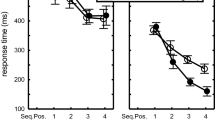Abstract
The present study attempts to characterize the contextual conditions (i.e., addition versus omission of elements) that enable or prevent transfer of an acquired skill. The effect of learning and transfer from part-to-whole and from whole-to-part was studied with the serial reaction time (SRT) task. In this study, two alternative sequences of the SRT task were utilized, a short (i.e., ‘part’) sequence consisting of six elements (ADBACD), and a long (i.e., ‘whole’) one consisting of 12 elements (BDCADBACDABC) in which the short sequence was embedded. Three groups participated in the study: one was trained with the ‘whole’ sequence and two with the ‘part’ sequence (differing in the number of initial training trials performed), for six blocks followed by a random block. Then, for an additional block, each group was divided into two subgroups, one which continued to practice the same sequence, while the other was transferred to the alternate sequence (i.e., ‘part-to-whole’ and ‘whole-to-part’). Results indicated that the group that first practiced the ‘whole’ and then the ‘part’ sequence showed full transfer, while the other group showed only partial transfer from the ‘part’ to ‘whole’ sequence. The findings of the present study are inconsistent with Thorndike’s principle of identical elements, and, instead, indicate that full transfer is enabled in spite of certain contextual changes (i.e., omissions), but only partial transfer is enabled when other changes are applied (i.e., additions).






Similar content being viewed by others
References
Abrahamse, E. L., Ruitenberg, M. F. L., De Kleine, E., & Verwey, W. B. (2013). Control of automated behavior: insights from the discrete sequence production task. Frontiers in Human Neuroscience, 7, 1–16.
Abrahamse, E. L., & Verwey, W. B. (2008). Context dependent learning in the serial RT task. Psychological Research, 72, 397–404.
Adi-Japha, E., Karni, A., Parnes, A., Loewenschuss, I., & Vakil. E. (2008). A shift in task routines during the learning of a motor skill: group averaged data may mask critical phases in the individuals’ acquisition of skilled performance. Journal of Experimental Psychology, Learning, Memory, and Cognition, 6, 1544–1551.
Ahlum-Heath, M. E., & Di Vesta, F. J. (1986). The effect of conscious controlled verbalization cognitive strategy on transfer in problem solving. Memory and cognition, 14(3), 281–285.
Anderson, J. R. (1982). Acquisition of cognitive skill. Psychological Review, 89, 369–406.
Averbeck, B. B., Sohn, J. W., & Lee, D. (2006). Activity in prefrontal cortex during dynamic selection of action sequences. Nature Neuroscience, 9, 276–282.
Brown, R. M., & Robertson, E. M. (2007). Off-line processing: reciprocal interactions between declarative and procedural memories. Journal of Neuroscience, 27, 10468–10475.
Clawson, D. M., Healy, A. F., Ericsson, K. A., & Bourne, L. E. Jr. (2001). Retention and transfer of Morse code reception skill by novices: Part-whole training. Journal of Experimental Psychology: Applied, 7, 129–142.
Fitts, P. M. (1964). Perceptual - motor skill learning. In A. W. Melton (Ed.), Categories of human learning. New York: Academic Press.
Fontana, F. E., Mazzarado, O., Furtado, O., & Gallagher, J. D. (2009). Whole and part practice: A meta-analysis. Perceptual and Motor Skills, 109, 517–530.
Jiménez, L. (2008). Taking patterns for chunks: is there any evidence of chunk learning in continuous serial reaction-time tasks? Psychological Research, 72, 387–396.
Jiménez, L., Méndez, A., Pasquali, A., Abrahamse, E. L., & Verwey, W. B. (2011). Chunking by colors: Assessing discrete learning in a continuous serial reaction-time task. Acta Psychologica, 137, 318–329.
Karni, A., Meyer, G., Rey-Hipolito, C., Jezzard, P., Adams, M. M., Turner, R., & Ungerleider, L. G. (1998). The acquisition of skilled motor performance: fast and slow experience-driven changes in primary motor cortex. Proceedings of the National Academy of Sciences, 95(3), 861–868.
Korman, M., Raz, N., Flash, T., & Karni, A. (2003). Multiple shifts in the representation of a motor sequence during the acquisition of skilled performance. Proceedings of the National Academy of Sciences of the USA. 100, 12492–12497.
Mattoon, J. S. (1994). Designing instructional simulations: Effects of instructional control and type of training task on developing display-interpretation skills. International Journal of Aviation Psychology, 4, 189–209.
Muller, B. (1999). Use specificity of cognitive skills: Evidence for production rules? Journal of Experimental Psychology: Learning, Memory, and Cognition, 25, 191–207.
Naylor, G., & Briggs, J. (1963). Effects of task complexity and task organization on the relative efficiency of part and whole training methods. Journal of Experimental Psychology, 65, 217–224.
Nissen, M. J., & Bullemer, P. (1987). Attentional requirements of learning: Evidence from performance measures. Cognitive Psychology, 19, 1–32.
Park, J. H., Wilde, H., & Shea, C. H. (2004). Part-whole practice of movement sequences. Journal of Motor Behavior, 36, 51–61.
Pascual-Leone, A., Grafman, J., Clark, K., Stewart, M., Massaquoi, S., Lou, J.-S., & Hallett, M. (1993). Procedural learning in Parkinson’s disease and cerebellar degeneration. Annual Neurology, 34, 594–602.
Rand, M. K., Hikosaka, O., Miyachi, S., Lu X., Nakamura, K., Kitaguchi, K., & Shimo, Y. (2000). Characteristics of sequential movements during early learning periods in monkeys. Experimental Brain Research, 131, 293–304.
Reed, J., & Johnson, P. (1994). Assessing implicit learning with indirect tests: determining what is learned about sequence structure. Journal of Experimental Psychology: Learning, Memory, and Cognition, 20, 585–594.
Rozanov, S., Keren, O., & Karni, A. (2010). The specificity of memory for a highly trained finger movement sequence: Change the ending, change all. Brain Research, 1331, 80–87.
Ruitenberg, M. F. L., Abrahamse, E. L., De Kleine, E., & Verwey, W. B. (2012a). Context-dependent motor skill: Perceptual processing in memory-based sequence production. Experimental Brain Research, 222, 31–40.
Ruitenberg, M. F. L., De Kleine, E., Van der Lubbe, R. H., Verwey, W. B., & Abrahamse, E. L. (2012b). Context-dependent motor skill and the role of practice. Psychological Research, 76, 812–820.
Ruitenberg, M. F. L., Verwey, W. B., & Abrahamse, E. L. (2015). What determines the impact of context on sequential action? Human Movement Science, 40, 298–314.
Schmidt, R. A., & Wrisberg, C. A. (2008). Motor learning and performance: a problem-based learning approach (4th edn.). Champaign: Human Kinetics.
Sosnik, R., Hauptmann, B., Karni, A., & Flash, T. (2004). When practice leads to co-articulation: The evolution of geometrically defined movement primitives. Experimental Brain Research, 156, 422–438.
Speelman, C. P., & Kirsner, K. (2001). Predicting transfer from training performance. Acta Psychological, 108, 247–281.
Vakil, E., Karni, A., & Loewenschuss, I. (2002). Time delay and transfer in different stages of learning the tower of Hanoi. 43rd Annual Meeting of the Psychonomic Society.
Verwey, W. B. (2003). Effect of sequence length on the execution of familiar keying sequences: Lasting segmentations and preparation? Journal of Motor and Behavior, 35, 343–354.
Verwey, W. B. (2003a). Processing modes and parallel processors in producing familiar keying sequences. Psychological Research, 67, 106–122.
Verwey, W. B., & Dronkert, Y. (1996). Practicing a structured continuous key-pressing task: Motor chunking or rhythm consolidation? Journal of Motor Behavior, 28, 71–79.
Willingham, D. B., Nissen, M. J., & Bullemer, P. (1989). On the development of procedural knowledge. Journal of Experimental Psychology: Learning, Memory, and Cognition, 15(6), 1047–1060.
Author information
Authors and Affiliations
Corresponding author
Ethics declarations
Funding
We declare that this project was not funded. The study was approved, as required, by the Institutional Review Board of Bar-Ilan University.
Informed consent
Informed consent was obtained from all participants.
Conflict of interest
No conflicts of interest exist.
Additional information
This study was carried out as part of a PhD dissertation by Zipi Rhein at Bar Ilan University, Ramat Gan, Israel.
Rights and permissions
About this article
Cite this article
Rhein, Z., Vakil, E. Motor sequence learning and the effect of context on transfer from part-to-whole and from whole-to-part. Psychological Research 82, 448–458 (2018). https://doi.org/10.1007/s00426-016-0836-4
Received:
Accepted:
Published:
Issue Date:
DOI: https://doi.org/10.1007/s00426-016-0836-4




